ASSESSMENT OF WATER ENVIRONMENT QUALITY IN HINH RIVER BASIN, PHU YEN PROVINCE
Joint Vietnam-Russia Tropical Science and Technology Research Center
No. 63 Nguyen Van Huyen, Nghia Do, Cau Giay, Hanoi
Số điện thoại: 0977866230; Email: ntkoanh166@gmail.com
Nội dung chính của bài viết
Tóm tắt (Abstract)
The Hinh River basin is one of the regions with abundant surface water resources in Phu Yen Province, encompassing a diverse system of rivers, streams, ponds, and reservoirs. The water quality of a river describes its biological and physicochemical characteristics. In this study, 22 water sampling points were monitored during the dry season. The water quality in the river basin was evaluated based on parameters such as pH, DO, COD, total nitrogen, total phosphorus, As, Cd, Pb, Cu, Zn, Hg, coliform, and E. coli at each specific location according to the QCVN 08:2023 standard and the VN_WQI index. The research results show that the VN_WQI ranges from 60 to 99, with 20 out of 22 monitoring locations having a VN_WQI value ≥ 76, indicating good to very good water quality that meets the requirements for irrigation and waterway transportation. Some points meet the water quality standards for domestic use after appropriate treatment. When assessing water quality by individual parameters, only the TSS parameter consistently reached level A, indicating good water quality at all sampling points. However, the results also indicate signs of localized pollution in the Hinh River basin at some monitoring locations based on the total nitrogen, COD, coliform, and E. coli parameters. The cause is waste from agricultural and livestock farming activities of people living along the Hinh River basin. This study provides additional data on surface water quality, serving as a basis for developing management measures, rational use, and protection of water quality in the Hinh River basin.
Từ khóa (Keywords)
Hinh River basin, surface water quality, water quality index VN_WQI.
Chi tiết bài viết
Highlights
The surface water quality of the Hinh River basin is evaluated using individual water quality parameters as well as the Water Quality Index (WQI).
According to the VN_WQI index, the overall water quality of the Hinh River basin is rated as good.
However, certain parameters, such as total nitrogen, Chemical Oxygen Demand (COD), E. coli, and total coliform at some sampling locations, are found to be at average to very poor levels, as defined by QCVN 08:2023/BTNMT.
1. INTRODUCTION
Song Hinh is a mountainous district located in the southwest of Phu Yen Province, approximately 60 km from Tuy Hoa city, with geographical coordinates ranging from 12°45' to 13°06' north latitude and 108°40' to 109°07' east longitude. This area, líe between the delta and the highlands, forms the upper and middle reaches of a system of large rivers and streams that flow through the southern part of the province and hold significant importance for its protection, water reserves, and ecological environment. The Hinh River boasts abundant and relatively rich surface water resources, forming a fairly uniform system of rivers and streams that includes the Ba River, Krong H'Nang River, Hinh River, and Con River, as well as small streams, ponds, and reservoirs. The river system is a water source for production and daily life, with great potential for irrigation and hydropower development.
Currently, the surface water quality of rivers is of great concern to scientists. Rivers not only provide energy and water for human needs but also play a role in channeling urban, industrial, and agricultural wastewater into large basins, making them some of the most vulnerable water bodies to pollution [1]. The formation of reservoirs from hydroelectric projects in river basins has effectively supported agricultural irrigation, aquaculture, and water regulation in downstream areas. However, the diversion of some hydroelectric projects to other basins has not been fully considered, leading to changes in the hydrological regime and causing significant impacts on ecosystems and socio-economic development activities in river basins [2]. The water quality of river basins describes the biological, chemical, and physical characteristics of river water [3]. While the quality of river basin water changes naturally, it often includes significant pollutants in the form of dissolved ions, suspended substances, and living organisms. The characteristics and nature of these pollutants vary depending on the level of development along the river, the size of the river, human activities, and the hydrological characteristics of the basin [4]. Therefore, assessments of surface water quality are necessary to provide a basis for formulating policies for the rational use of surface water resources and for developing solutions to protect surface water environments from pollution risks.
Typically, the assessment of surface water quality involves the analysis of distinct parameters, followed by a comparison with the limit values outlined in the national standard [5]. Pollutants, grouped based on the physical, chemical, and biological properties of water, determine water quality. We can collectively integrate these indicators into a systematic, structured index scale, commonly known as the water quality index (WQI). It can convert a large amount of water pollution data into a dimensionless index value, which represents the level of pollution in water resources [6-9]. Considering the ability to integrate a group of water quality indicators into a simple, straightforward number, the WQI is considered a very effective and important communication tool for water managers and policymakers [10-12]. Many countries, including the US, Canada, Belgium, Turkey, India, Thailand, Malaysia, and Taiwan, have extensively researched and used the WQI. Most countries around the world, including Vietnam, have developed WQI calculation formulas for surface water environments. The Vietnam Environment Administration has also issued official technical guidelines for calculation and publication 1460/QD-TCMT.
In this study, we carried out sampling and analysis of the surface water environment to assess the water quality of the Hinh River Basin using separate water quality parameters and the VN_WQI. This database is useful for the rational exploitation and use of water resources in the Hinh River basin, as well as for the protection of the water environment.
2. RESEARCH MATERIALS AND METHODOLOGY
2.1. Time and location of sample collection
The study involved sampling at 22 locations in the Hinh River basin during the dry season, from late March to early April 2024 (Figure 1). The surface water sampling sites were distributed along the river basin, and their characteristics are summarized in Table 1.
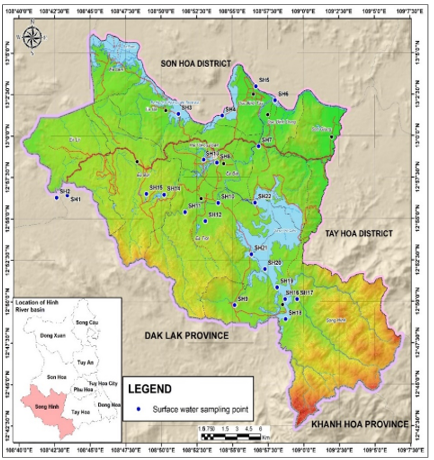
Figure 1. Map of water quality monitoring sites in the Hinh River Basin
Table 1. Location and characteristics of the sampling points
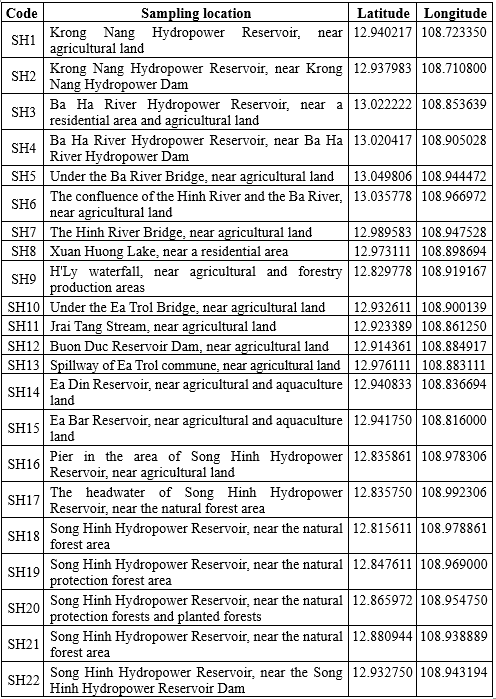
2.2. Methods for sampling and analyzing water environmental parameters
At each sampling site, single samples were collected according to the standards TCVN 6663-1:2011, TCVN 6663-4:2020, and TCVN 6663-6:2018. After sampling, the water samples were pretreated and stored following TCVN 6663-3:2016. We measured the samples in the field and analyzed them in the laboratory using the criteria and methods presented in Table 2. Excel software was used to process the analysis results, which were subsequently compared with the National Technical Regulation on Surface Water Quality (QCVN 08:2023/BTNMT).
Table 2. Analytical methods for determining water quality parameters

2.3. Methods for calculating the water quality index
The VN_WQI is calculated based on the results of analyzing surface water quality monitoring parameters and applying the calculation formula provided in Decision No. 1460/QĐ-TCMT issued in 2019 by the General Department of Environment on Technical Guidelines for Calculation and Publication of the Vietnam Water Quality Index. In this study, we selected 4 out of 5 parameter groups for the total WQI: Group 1 (pH values); Group 2 (organic parameters and nutrients - DO, COD, and PO43-); Group 3 (heavy metal parameters - As, Cd, Pb, Cu, Zn, and Hg); and Group 4 (coliform and E. coli parameters). The WQI for each parameter was calculated according to the Vietnam Environment Administration's guidelines. The final WQI was calculated using the following formula:

Where:
WQII: Calculation results for group 1 parameters (pH value);
WQIII: Calculation results for group 2 parameters (DO, COD, PO43-);
WQIIII: Calculation results for group 3 parameters (As, Cd, Pb, Cu, Zn, Hg);
WQIIV: Calculation results for group 4 parameters (Coliform and E. coli).
We calculated the water quality index based on a scoring scale (WQI value range) corresponding to the symbols and colors illustrated in Table 3 to assess the water quality for different purposes.
Table 3. VN_WQI value range and corresponding symbols and colors

3. RESULTS AND DISCUSSION
3.1. Assessing water quality in the Hinh River basin through individual parameters
The results of the measurement and analysis of water quality in the Hinh River Basin in the dry season of 2024 at 22 monitoring locations are presented in Table 4.
Table 4. Statistical value of monitoring parameters in the dry season in 2024

The data in Table 4 show that the pH values measured at 22 sample sites ranged from 6.3 to 8.8, and the average pH of the Hinh River Basin was 7.5±0.7. A comparison of the measured pH values with the water quality classification values according to the QCVN 08:2023/BTNMT revealed that 17/22 of the measured pH values were within the limit of 6.5 - 8.5, reaching level A as a good water quality level, and water can be used for domestic water supply purposes, such as swimming and playing in the water after appropriate handling measures. Three samples reached level B, which is the average water quality level; water can be used for industrial production and agricultural purposes after appropriate treatment measures are used; and 2 samples were at level D (samples SH1 and SH2). The water quality is very poor, which can affect fish and organisms living in aquatic environments.
Surface water samples taken from the Hinh River basin contained total suspended solids (TSS) ranging from 0.63 mg/L to 13.3 mg/L. According to QCVN 08:2023/BTNMT, all water samples receive an A rating, indicating their suitability for various water usage purposes.
The average concentration of dissolved oxygen (DO) in the water in the Hinh River basin was 5.90±1.17 mg/L, equivalent to the average DO value in the surface water of the Ba River basin (Phu Yen Province) monitored in the dry season in 2018, which was 5.45 mg/L [13]. Compared to the water quality classification scale according to QCVN 08:2023/BTNMT, out of 22 surface water samples taken in the Hinh River basin, 12 samples reached level A, and 8 samples reached level B (Figure 2). Before using water for irrigation of surrounding agricultural production areas, appropriate treatment measures must be applied when reaching level B. A water sample, SH8, was collected at Xuan Huong Lake. This lake serves as a regulating water body and is situated in a residential area. The dissolved oxygen (DO) level at this location is classified as level D. The lake's biochemical processes are sluggish due to its stationary water source and are influenced by the discharge of domestic wastewater from the surrounding residents.

Figure 2. Dissolved oxygen (DO) values and chemical oxygen demand (COD) in the Hinh River Basin
According to the analysis results, the COD in surface water in the Hinh River Basin ranged from 3.2 to 28.8 mg/L; the average COD in the Hinh River Basin was 13.8±7.74 mg/L, which was lower than the average COD value of 25.08 mg/L that was detected in the Ba River Basin in the dry season in 2018 [13]. According to the QCVN 08:2023/BTNMT water quality assessment classification, 11 samples reached level A, 2 samples reached level B, 3 samples reached level C, and 6 samples reached level D (Figure 2). At sampling point, SH6, a COD value of 28.8 mg/L was recorded, which is the highest in the Hinh River basin. This indicates signs of organic pollution in this area. Since this sampling point is located at the intersection of the Hinh River and the Ba River, there is a possibility of pollutant accumulation.
The total nitrogen and total phosphorus concentrations in the water in the Hinh River basin were used to assess the nutritional parameters. The average total nitrogen content in the water in the Hinh River basin was 2.28±0.93 mg/L. According to QCVN 08:2023/BTNMT, only the SH3 and SH4 samples achieved level B, indicating average water quality. The remaining samples received ratings of C and D, indicating poor and very poor water quality, with nitrogen compounds contaminating the water (Figure 3). The majority of the sampling points are situated close to agricultural areas where annual crops are grown. The use of fertilizers in these areas leads to an accumulation of nitrogen in the soil. This nitrogen then gets washed into the water, resulting in the pollution of nitrogen compounds in the Hinh River basin. Therefore, it is important to implement suitable measures to address nitrogen pollution in the water before using water from the Hinh River basin for irrigation. The total phosphorus content of most samples fell within the permissible limit of QCVN 08:2023/BTNMT (Level A), ranging from 0.01 to 0.05 mg/L. However, only the SH6 sample, which had a total phosphorus content of 0.38 mg/L, received a level B classification. At the SH6 sampling location, the total nitrogen (TN) and COD content was the highest among the 22 sampling sites. This indicates pollution at the confluence of the Hinh River and the Ba River. It is important to promptly implement water pollution treatment measures to prevent the spread of pollution to surrounding areas.

Figure 3. Total N concentration in the Hinh River basin
A study of heavy metal indicators in the country revealed that the amount of heavy metals in surface water at most sampling points is many times less than the highest level allowed by QCVN 08:2023/BTNMT. Almost no As, Cd, or Hg was detected in the water (Table 5).
Table 5. Results of the analysis of heavy metals in water in the Hinh River Basin
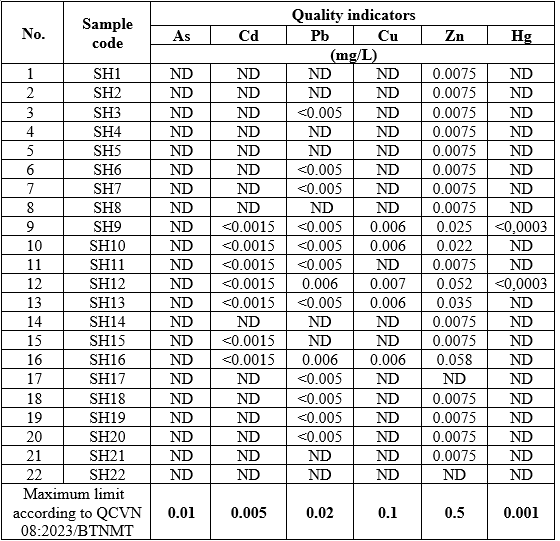
(ND: Not detected)
Coliform and E. coli parameters were used to evaluate biological indicators in the water of the Hinh River basin. Figure 4 clearly classifies the coliform values into three groups: Group 1 consists of 07 sampling locations with coliform values ≤ 1000 MPN/100 mL, reaching level A (good water quality according to QCVN 08:2023/BTNMT); Group 2 includes 14 sampling sites with coliform values reaching level B (average water quality); and Group 3 consists of only one sampling point (SH03), where the coliform value is 8164 MPN/100 mL, which is equivalent to level D (very poor quality water), due to the influence of domestic wastewater and livestock wastewater of rural residents in the surrounding area. Water treatment measures must be taken before using the water source at point SH3 for both domestic and agricultural purposes. We divided the analysis results for the E. coli parameters into two distinct groups. Group 1 consisted of 11 samples whose E. coli values did not exceed the permissible limit set by QCVN 08:2023/BTNMT, indicating that they do not pose a health risk to humans. Group 2, on the other hand, consisted of 11 samples whose E. coli values exceeded 20 MPN/100 mL. Of these, two sampling points, SH9 and SH10, have E. coli values that are 5-6 times higher than the permissible limit, posing a risk to human health.
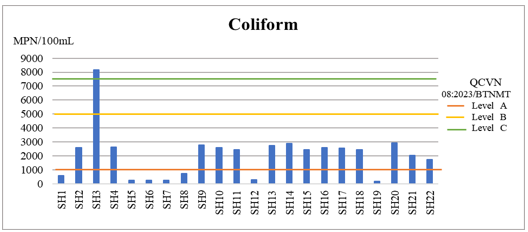
Figure 4. Coliform density in the water of the Hinh River Basin
3.2. Assessment of water quality in the Hinh River basin according to the VN_WQI
The calculation results from four groups of surface water environmental parameters in the Hinh River basin show that the VN_WQI ranges from 60 to 99. The assessment of the surface water environment in the Hinh River basin ranged from medium to very good, with 20/22 monitoring locations achieving a VN_WQI value of approximately 76 and only two sampling sites, SH2 and SH3, exhibiting medium water quality (Figure 5).
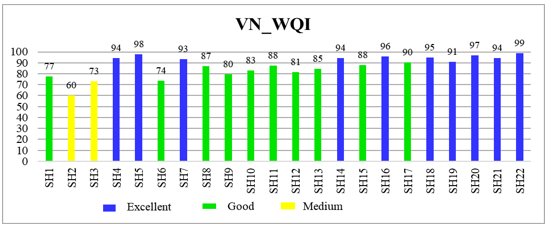
Figure 5. VN_WQI surface water quality index in the Hinh River basin
At the Song Hinh Hydropower Reservoir, the research team collected six surface water samples from SH17 to SH22, except for sampling site SH17, the upstreamlocation of the Song Hinh Reservoir, with a value of VN_WQI<91, which was assessed as having good water quality; other sampling points were assessed as having very good water quality. Thus, the Song Hinh Reservoir has very good water quality, is suitable for use for many different purposes and is good for domestic water supply purposes. The results of the calculation of the VN_WQI at sampling sites SH14 and the Ea Din Reservoir indicate that the lake has very good surface water quality. The Krong Hnang Hydropower Reservoir, Xuan Huong Lake, and Ea Bar Reservoir all have good surface water quality according to the VN_WQI. Only the Ba Ha River Hydropower Reservoir has an medium water quality assessed according to the VN_WQI index, making it suitable for irrigation and other equivalent purposes.
4. CONCLUSION
In this study, the water quality in the Hinh River basin was assessed by combining measurements and analyses of parameters at each monitoring location according to the QCVN 08:2023/BTNMT standard and applying the VN_WQI index calculation method during the dry season of 2024. The research results show that during this period the overall water quality in the Hinh River basin remained generally good, with the VN_WQI ranging from 60 to 99. At most of the surveyed sites, the water quality can meet the requirements for irrigation and waterway transportation, and some points have water qualities suitable for domestic water supply but require appropriate treatment measures. However, there are signs of localized pollution at specitic locations, particularly near the upper reaches of the Hinh River basin, where the Ba River from Gia Lai Province flows into Phu Yen Province and joins the Hinh River. Pollution was also detected at sites receiving wastewater mainly from agricultural activities and domestic sources.
Acknowledgments: The paper was completed based on data from the project "Research and propose solutions to manage and use water resources, protect the landscape and environment of the Hinh River basin, Phu Yen province" chaired by the Institute of Tropical Ecology, Joint Vietnam-Russia Tropical Science and Technology Research Center.
Author contributions: Nguyen Thi Kim Oanh: Laboratory sample analysis. Data processing and analysis. Writing and editing the article. Nguyen Quoc Khanh: Data processing. Editing the manuscript. Le Bao Hung, Tran Thi Nhan, Dinh Vu Anh Tu, Nguyen Thi Chinh, Do Tat Thinh, Ngo Trung Dung: Sampling and sample analysis.
Conflict of interest statement: The research was carried out from the funding source of the topic "Research and propose solutions to manage and use water resources, protect the landscape and environment of the Hinh River basin, Phu Yen province" chaired by the Institute of Tropical Ecology, Joint Vietnam-Russia Tropical Science and Technology Research Center.
Tài liệu tham khảo
2. Ministry of Natural Resources and Environment, National environmental report 2012, Surface Water Resources, 2012, pp. 17.
3. R.J. Davies-Colley, River water quality in New Zealand: an introduction and overview in Ecosystem services in New Zealand: conditions and trends, John R. Dymond, editor. Lincoln, Manaaki Whenua Press, 2013, pp. 432-447.
4. D.V. Chapman, Chapter 6 Rivers in Water quality assessments: a guide to the use of biota, sediments, and water in environmental monitoring, 2nd ed., D.V. Chapman, editor., London, CRC Press, 1996, pp. 243-314.
5. Nguyen Khac Thanh et al., Assessment of surface water quality of lakes in Da Nang inner city, DTU Journal of Science and Technology, 4(47), pp. 54-64, 2021.
6. H. Boyacioglu, Development of a water quality index based on a European classification scheme, Water SA, Vol. 33, No.1, pp. 101-106, 2007.
7. S. Darapu, B. Sudhakar, K.S.R. Krishna, P.V. Rao and M.C.Sekhar, Determining water quality index for the evaluation of water quality of river Godavari, International Journal of Engineering Research and Application, Vol. 1, Issue 2, pp.174-182, 2011.
8. R.A. Kalyani, S.G. Rao, B. Nageshwarao and B. Thirupathi, Water quality index in four sites of the Cherlapally lake, Telangana state, International Journal for Innovative Research in Science and Technology, Vol. 3, Issue 04, Sep., pp. 66-73, 2016.
9. S.H. Ewaid, S.A. Abed and S.A. Kadhum, Predicting the Tigris River water quality within Baghdad, Iraq by using water quality index and regression analysis, Environmental Technology & Innovation, Vol. 11, Aug., pp. 390-398, 2018.
10. P.A. Zandbergen, K.J. Hall, Analysis of the British Columbia water quality index for watershed managers: a case study of two small watershed, Water Quality Research Journal of Canada, 33 (4), pp. 519-550, 1998.
11. A.A. Khan, A. Tobin, R. Paterson, H. Khan and R. Warren, Application of CCME procedures for deriving site-specific water quality guidelines for the CCMe water quality index, Water Quality Research Journal, 40 (4), pp. 448-456, 2005.
12. N. Kankal, M. Indurkar, S. Gudadhe and S. Wate, Water quality index of surface water bodies of Gujarat, India, Asian Journal of Experimental Sciences, Vol. 26, No. 1, pp. 39-48, 2012.
13. Nguyen Thi Bich, Phan Thi Thanh Hang and Ngo Thanh Nga, Assessment of water quality in the Ba river basin in Phu Yen province, during the period from 2016 to 2018, Journal of Water Resources, No. 3, pp. 37-48, 2021.